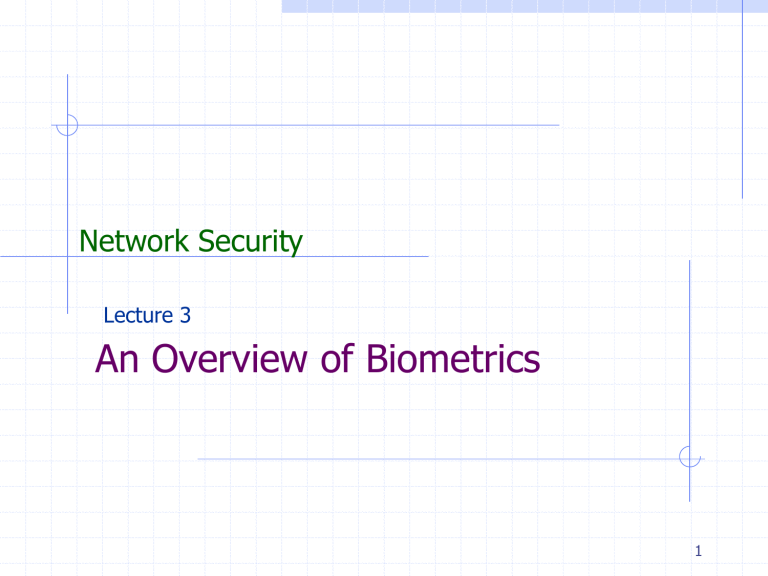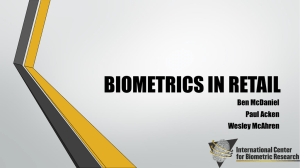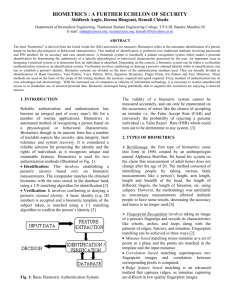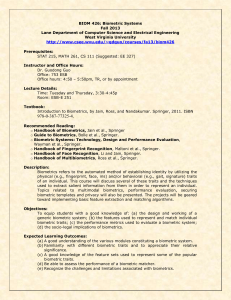Single Sign-On Systems

Network Security
Lecture 3
An Overview of Biometrics
1
Outline of presentation
Introduction to biometric authentication
Biometric methods
State of the art in biometrics
A critical view on the state of the art
2
What is user authentication?
The process of confirming an individual’s identity, either by verification or by identification
A person recognising a person
Access control (PC, ATM, mobile phone)
Physical access control (house, building, area)
Identification (passport, driving licence)
3
Authentication methods
Token – “something that you have”
• such as smart card, magnetic card, key, passport,
USB token
Knowledge – “something that you know”
• such as password, PIN
Biometrics – “something that you are”
• A physiological characteristic (such as fingerprint, iris pattern, form of hand)
• A behavioural characteristic (such as the way you sign, the way you speak)
4
What is biometrics?
The term is derived from the Greek words bio
(= life) and metric (= to measure)
Biometrics is the measurement and statistical analysis of biological data
In IT, biometrics refers to technologies for measuring and analysing human body characteristics for authentication purposes
Definition by Biometrics Consortium – automatically recognising a person using distinguishing traits
5
How does it work?
Each person is unique
What are the distinguishing traits that make each person unique?
How can these traits be measured?
How different are the measurements of these distinguishing traits for different people?
6
Verification vs. identification
Verification (one-to-one comparison) – confirms a claimed identity
•
Claim identity using name, user id, …
Identification (one-to-many comparison) – establishes the identity of a subject from a set of enrolled persons
•
•
•
Employee of a company?
Member of a club?
Criminal in forensics database?
7
Biometric identifiers
Universality
Uniqueness
Stability
Collectability
Performance
Acceptability
Forge resistance
8
Biometric technologies
Covered in ANSI X9.84-2003 :
Fingerprint biometrics – fingerprint recognition
Eye biometrics – iris and retinal scanning
Face biometrics – face recognition using visible or infrared light (called facial thermography)
Hand geometry biometrics – also finger geometry
Signature biometrics – signature recognition
Voice biometrics – speaker recognition
9
Other biometric methods
Found in the literature:
Vein recognition (hand)
Palmprint
Gait recognition
Body odour measurements
Ear shape
DNA
Keystroke dynamics
10
Static vs. dynamic biometric methods
Static (also called physiological) biometric methods – authentication based on a feature that is always present
Dynamic (also called behavioural) biometric methods – authentication based on a certain behaviour pattern
11
Classification of biometric methods
Static
Fingerprint r.
Retinal scan
Iris scan
Hand geometry
Dynamic
Signature r.
Speaker r.
Keystroke dynamics
12
Biometric system architecture
Major components of a biometric system:
Data collection
Signal processing
Matching
Decision
Storage
Transmission
13
Biometric system model
Data collection
Raw data
Signal processing
Extracted features
Matching
Template
Storage
Match score
Application
Authentication decision
Decision
14
Data collection subsystem
Also called data acquisition
Comprises input device or sensor that reads the biometric information from the user
Converts biometric information into a suitable form for processing by the remainder of the biometric system
Examples: video camera, fingerprint scanner, digital tablet, microphone, etc.
15
Requirements for data collection
Sampled biometric characteristic must be similar to the user’s enrolled template
The users may require training
Adaptation of the user’s template or reenrolment may be necessary to accommodate changes in physiological characteristics
Sensors must be similar, so that biometric features are measured consistently at other sensors
16
Changes in data collection
The biometric feature may change
The presentation of the biometric feature at the sensor may change
The performance of the sensor itself may change
The surrounding environmental conditions may change
17
Signal processing subsystem
For feature extraction
Receives raw biometric data from the data collection subsystem
Transforms the data into the form required by matching subsystem
Discriminating features extracted from the raw biometric data
Filtering may be applied to remove noise
18
Matching subsystem
Key role in the biometric system
Receives processed biometric data from signal processing subsystem and biometric template from storage subsystem
Measures the similarity of the claimant’s sample with the reference template
Typical methods: distance metrics, probabilistic measures, neural networks, etc.
The result is a number known as match score
19
Decision subsystem
Interprets the match score from the matching subsystem
A threshold is defined. If the score is above the threshold, the user is authenticated. If it is below, the user is rejected
Typically a binary decision: yes or no
May require more than one submitted samples to reach a decision: 1 out of 3
May reject a legitimate claimant or accept an impostor
20
Storage subsystem
Maintains the templates for enrolled users
One or more templates for each user
The templates may be stored in:
physically protected storage within the biometric device conventional database portable tokens, such as a smartcard
21
Transmission subsystem
Subsystems are logically separate
Some subsystems may be physically integrated
Usually, there are separate physical entities in a biometric system
Biometric data has to be transmitted between the different physical entities
Biometric data is vulnerable during transmission
22
Enrolment
Process through which the user’s identity is bound with biometric template data
Involves data collection and feature extraction
Biometric template is stored in a database or on an appropriate portable token (e.g. a smart card)
There may be several iterations of this process to refine biometric template
23
Security of enrolment
Requirements for enrolment:
Secure enrolment procedure
Binding of the biometric template to the enrolee
Check of template quality and matchability
24
Biometric system model
Data collection
Raw data
Signal processing
Extracted features
Matching
Template
Storage
Match score
Application
Authentication decision
Decision
25
Possible decision outcomes
A genuine individual is accepted
A genuine individual is rejected (error)
An impostor is rejected
An impostor is accepted (error)
26
Errors
Balance needed between 2 types of error:
Type I: system fails to recognise valid user
(‘false non-match’ or ‘false rejection’)
Type II: system accepts impostor (‘false match’ or ‘false acceptance’)
Application dependent trade-off between two error types
27
Tolerance threshold
Error tolerance threshold is crucial and application dependent
Tolerance too large causes Type II errors (impostors admitted)
Tolerance too small causes Type I errors
(legitimate users rejected)
Equal error rate (EER): false non-match
(FRR) = false match (FAR)
28
Type II / FAR error curve
Biometric feature accepted
Biometric feature rejected
FAR
False acceptances False rejections
Tolerance Threshold
29
Type I / FRR error curve
FRR
Biometric feature accepted
Biometric feature rejected
False acceptances False rejections
Tolerance Threshold
30
Error curves of biometric authentication methods
FRR
Biometric feature accepted
Biometric feature rejected
FAR
EER Equal Error Rate
False acceptances False rejections
Tolerance Threshold
31
Biometric technologies
Fingerprint recognition
Hand geometry reading
Retinal scan
Iris scan
Face recognition
Signature recognition
Speaker verification
32
Liveness detection
Make sure that input at biometric sensor originates with life user
33
Fingerprint recognition
Ridge patterns on fingers uniquely identify people
Classification scheme devised in 1890s
Major features: arch, loop, whorl
Each fingerprint has at least one of the major features and many “small features” (so-called minutiae )
34
Features of fingerprints
35
Fingerprint recognition (cont.)
In an automated system, the sensor must minimise the image rotation
Locate minutiae and compare with reference template
Minor injuries are a problem
Liveness detection is important
(detached real fingers, gummy fingers, latent fingerprints)
36
Fingerprint authentication
Basic steps for fingerprint authentication:
Image acquisition
Noise reduction
Image enhancement
Feature extraction
Matching
37
Fingerprint processing a) Original b) Orientation c) Binarised d) Thinned e) Minutiae f) Minutiae graph
38
Assessment – fingerprint recognition
Advantages
Mature technology
Easy to use/nonintrusive
High accuracy
(comparable to PIN authentication)
Long-term stability
Ability to enrol multiple fingers
Comparatively low cost
Disadvantages
Inability to enrol some users
Affected by skin condition
Sensor may get dirty
Association with forensic applications
39
Hand geometry
Features: dimensions and shape of the hand, fingers, and knuckles as well as their relative locations
Two images taken, one from the top and one from the side
40
Hand geometry measurements
41
Assessment – hand geometry
Advantages
Mature technology
Non-intrusive
High user acceptance
No negative associations
Disadvantages
Low accuracy
High cost
Relatively large readers
Difficult to use for some users
(children, arthritis, missing fingers or large hands)
42
Eye biometrics
Iris scanning
Coloured portion of the eye surrounding the pupil
– trabecular meshwork
Complex iris pattern is used for authentication
Retinal scanning
Retinal vascular pattern on the back inside the eyeball
Pattern of blood vessels used for authentication
43
Retinal scanning
Accurate biometric measure
Genetic independence: identical twins have different retinal pattern
Highly protected, internal organ of the eye
44
Retina: eye and scan circle
45
Assessment – retinal scanning
Advantages
Potential for high accuracy
Long-term stability
Feature is protected from variations
(regarding external environment)
Genetic independence
Disadvantages
Difficult to use
Intrusive
Perceived health threat
High sensor cost
46
Iris scanning
Iris pattern possesses a high degree of randomness: extremely accurate biometric
Genetic independence: identical twins have different iris patterns
Stable throughout life
Highly protected, internal organ of the eye
Patterns can be acquired from a distance
(1m)
Not affected by contact lenses or glasses
47
Iris scanning
Iris code developed by John Daugman at
Cambridge University
Extremely low error rates
Fast processing
Monitoring of pupil’s oscillation to prevent fraud
Monitoring of reflections from the moist cornea of the living eye
48
The iris code
49
Assessment – iris recognition
Advantages
Potential for high accuracy
Resistance to impostors
Long term stability
Fast processing
Disadvantages
Intrusive
Some people think the state of health can be detected
High cost
50
Face biometrics
Static controlled or dynamic uncontrolled shots
Visible spectrum or infrared
(thermograms)
Non-invasive, hands-free, and widely accepted
Questionable discriminatory capability
51
Face recognition
Visible spectrum: inexpensive
Most popular approaches:
Eigenfaces,
Local feature analysis.
Affected by pose, expression, hairstyle, make-up, lighting, glasses
Not a reliable biometric measure
52
Assessment – face recognition
Advantages
Non-intrusive
Low cost
Ability to operate covertly
Disadvantages
Affected by appearance and environment
Low accuracy
Identical twins attack
Potential for privacy abuse
53
Facial thermogram
Captures the heat emission patterns derived from the blood vessels under the skin
Infrared camera: unaffected by external changes (even plastic surgery!) or lighting
Unique but accuracy questionable
Affected by emotional and health state
54
Assessment of facial thermogram
Advantages
Non-intrusive
Stable
Not affected by external changes
Identical twins resistant
Ability to operate covertly
Disadvantages
High cost (infrared camera)
New technology
Potential for privacy abuse
Affected by state of health
55
Signature recognition
Handwritten signatures are an accepted way to authenticate a person
Automatic signature recognition measures the dynamics of the signing process
Signature generating process is a trained reflex - imitation difficult especially ‘in real time’
56
Dynamic signature recognition
Variety of characteristics can be used:
angle of the pen, pressure of the pen, total signing time, velocity and acceleration, geometry.
57
Assessment of signature recognition
Advantages
Resistance to forgery
Widely accepted
Non-intrusive
No record of the signature
Disadvantages
Signature inconsistencies
Difficult to use
Large templates
(1K to 3K)
Problem with trivial signatures
58
Speaker verification
Linguistic and speaker dependent acoustic patterns
Speaker’s patterns reflect:
anatomy (size and shape of mouth and throat), behavioural (voice pitch, speaking style)
Heavy signal processing involved
(spectral analysis, periodicity, etc.)
59
Speaker recognition systems
Text-dependent: predetermined set of phrases for enrolment and identification
Text-prompted: fixed set of words, but user prompted to avoid recorded attacks
Text-independent: free speech, more difficult to accomplish
60
Assessment – speaker recognition
Advantages
Use of existing telephony infrastructure or simple microphones
Easy to use/nonintrusive/hands free
No negative association
Disadvantages
Pre-recorded attack
Variability of the voice (ill or drunk)
Affected by background noise
Large template (5K to 10K)
Low accuracy
61
Choosing the biometrics
Does the application need identification or authentication?
Is the collection point attended or unattended?
Are the users used to the biometrics?
Is the application covert or overt?
62
Choosing the biometrics
Are the subjects cooperative or noncooperative?
What are the storage requirement constraints?
How strict are the performance requirements?
What types of biometrics are acceptable to the users?
63
State of the Art in Biometrics
18 th October 2004
64
Outline
Application domains for biometric products
Overview of biometric products
How good are biometrics today?
65
Application domains (I)
Access control
To devices
Cellular phones
Logging in to computer, laptop, or PDA
Cars
Guns, gun safes
To local services
Debitting money from cash dispenser
Accessing data on smartcard
To remote services
E-commerce
E-business
66
Application domains (II)
Physical access control
To high security areas
To public buildings or areas
Time & attendance control
Identification
Forensic person investigation
Social services applications, e.g. immigration or prevention of welfare fraud
Personal documents, e.g. electronic drivers license or ID card
67
Fingerprint recognition: overview
Sensors
Optical sensors
Ultrasound sensors
Chip-based sensors
Thermal sensors
Integrated products
For identification – AFIS systems
For verification
68
Fingerprint recognition: sensors (I)
Optical fingerprint sensor
[Fingerprint Identification Unit
FIU-001/500 by Sony]
Electro-optical sensor
[DELSY® CMOS sensor modul]
Capacitive sensor
[FingerTIP™ by Infineon]
69
Fingerprint recognition: sensors (II)
E-Field Sensor
[FingerLoc™ by Authentec]
Thermal sensor
[FingerChip™ by ATMEL
(was: Thomson CSF)]
70
Fingerprint recognition: integrated systems (I)
[BioMouse™ Plus by American Biometric Company]
Japanese handset
[F505i by NTT DoCoMo]
[ID Mouse by Siemens]
71
Fingerprint recognition: integrated systems (II)
[TravelMate 740 by Compaq und Acer]
Keyboard [G 81-12000 by Cherry]
System including fingerprint sensor, smartcard reader and display by DELSY
72
Face recognition
Face recognition system
[TrueFace Engine by Miros]
Face recognition system
[One-to-One
™ by Biometric Access Corporation]
73
Iris recognition
System for passive iris recognition by Sensar
System for active iris recognition by
IrisScan 74
Iris recognition system at
Heathrow airport
Large-scale trial of iris recognition system at Heathrow
Airport for immigration control
(no passports) http://news.bbc.co.uk/1
/hi/uk/1808187.stm
75
Retinal recognition
Retinal recognition system [Icam 2001 by Eyedentify]
76
Hand geometry reading
Hand geometry reader by Recognition Systems
Hand geometry reader for two finger recognition by BioMet Partners
77
Dynamic signature verification
(I)
Electronic pen [LCI-SmartPen]
78
Dynamic signature verification
(II)
Digitising tablet by
Wacom Technologies
Digitising tablet [Hesy Signature Pad by BS Biometric Systems GmbH]
79
Multimodal biometric systems
Combination of biometric technologies, e.g.
Fingerprint and face recognition
Face recognition and lip movement
Fingerprint recognition and dynamic signature verification
Increase the level of security achieved by the system
Enlarge the user base
80
Which biometric method / product is best?
Depends on the application
reliability security performance cost user acceptance liveness detection users that are unsuitable size of sensor
81
How good are biometric products?
How can we find out, how good a biometric product is?
Empirical tests of the product
In 2002, there were two independent test series of biometric products
in Japan in Germany
82
Different threat scenarios
1.
Regular biometric sensor using artificially generated biometric data
2.
Replay attack of eavesdropped biometric data
3.
Manipulation of stored biometric reference data
83
Test in Japan
Tsutomu Matsumoto, a Japanese cryptographer working at Yokohama National
University
11 state-of-the-art fingerprint sensors
2 different processes to make gummy fingers
from live finger
from latent fingerprint
Gummy fingers fooled all 11 fingerprint sensors 80% of the time
84
Test in Germany (I)
Computer magazine c’t (see http://www.heise.de/ct/english/02/11/114/ )
11 biometric sensors
9 fingerprint sensors,
1 face recognition system, and
1 iris scanner
Fingerprint sensors –
Reactivate latent fingerprints (optical and capacitive sensors)
Apply latex finger (thermal sensor)
85
Test in Germany (II)
Face recognition system –
Down- (up-)load biometric reference data from
(to) hard disk
No or only weak liveness detection
Iris recognition –
Picture of iris of enrolled person with cut-out pupil, where a real pupil is displayed
All tested biometric systems could be fooled, but the effort differed considerably
86
The National ID Card Scheme
On 11 November 2003, the Home
Secretary announced the national ID card scheme for the UK
Card would include basic personal information, a digital photo and a biometric identifier (facial recognition, iris scan, fingerprint)
By 2013, 80% of the adult population would have an ID card
87
Biometric British Passports
The UKPS is planning to implement a facial recognition image biometric in the British Passport book from late 2005/early 2006
UKPS Biometric Pilot, lasting six months, started on
26 th April 2004 to evaluate issues around biometric recording using facial recognition, iris pattern and fingerprint
See http://www.homeoffice.gov.uk/docs2/ identity_cards_nextsteps_031111.pdf
to read about the Home Secretary’s viewpoint
See http://management.silicon.com/government/
0,39024677,39121205,00.htm
to read some critical viewpoints
88
Conclusions
Biometric technology has great potential
There are many biometric products around, regarding the different biometric technologies
Since September 11 th , biometric products are pushed forward
Shortcomings of biometric systems due to
Manufacturers ignorance of security concerns
Lack of quality control
Standardisation problems
Manufacturers have to take security concerns serious
89
References
ANSI X9.84-2003: Biometric Information
Management and Security for the Financial
Services Industry.
Jain et. al., Biometrics: Personal Identification in
Networked Society, Kluwer Academic Publishers,
1998.
Nanavati et. al., Biometrics: Identity Verification in a Networked Society, Wiley, 2002.
Maltoni et. al., Handbook of Fingerprint
Recognition, Springer, 2003.
Woodward et. al., Biometrics – Identity Assurance in the Information Age, McGraw-Hill 2003.
90
References (cont.)
The Biometric Consortium: http://www.biometrics.org/
Thalheim et. al., Body Check, c’t 11/2002, http://www.heise.de/ct/english/02/11/114/
T. Matsumoto et. al., Impact of Artificial
Gummy Fingers on Fingerprint Systems, Proc.
Of SPIE Vol. 4677, 2002.
Scheuermann, Schwiderski-Grosche, and
Struif, Usability of Biometrics in Relation to
Electronic Signatures, GMD Report 118, Nov
2000.
91
Pass rates
100 FRR
FAR
92






